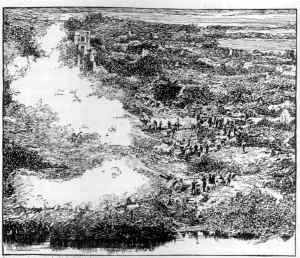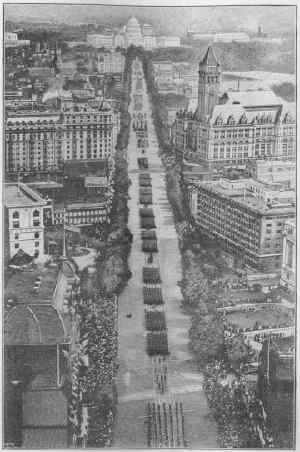Resource Center OLLibrary
|
1918 ] |
|
429 |
Beyond these hills on the west is the great Forest of Argonne.
There are many small farmhouses and villages scattered throughout
the country, but there are few good roads. The Germans in and
about the Forest had long made themselves very much at home in
their well-built, comfortable quarters. They were on their guard
against intruders and defied the Yankees to get through their

From a photograph, U. S. official
OUR ARTILLERY CLEANING OUT THE ARGONNE
barbed-wire entanglements, to get past their machine guns, or
to get over their fortified lines of defense. in all the Kaiser
must have had at least half a million troops waiting to greet us
with heavy artillery, with machine guns, and with unlimited
showers of gas shells.
While we made our attack from the southeast side
of the Argonne, a strong French army attacked from the west side.
Our forces began the fighting and kept it up, day after day, for
over a month.
|
430 |
|
[1917-1918 |
It was "our greatest battle," and men coming from every state
in the Union took part in it -- what is more, they won it. When
that day came they reported that the last German had been squeezed
out" of the Argonne country.
While this contest was going on, the British, French,
and Americans in the western part of France had not been idle. The
most remarkable thing that they did was to storm the famous
Hindenburg Line near its center.1 They not only broke
through but they went some distance beyond. It was what boxers
call a "knock-out blow." The Germans saw that it would be
impossible for them to make any long-continued resistance. They
had to choose between quickening their pace homeward or
surrendering where they stood.
On the east Pershing's "all-American army" was
advancing northward on both sides of the Meuse, intent on striking
a similar blow in that direction. The Germans held a railway line
which was crowded day and night with freight cars bringing
provisions and war material from Metz, Germany, to their armies in
northwestern France.2 On November 6 we reached that
line and took possession of it in the vicinity of
Sedan.3 (See Map, p. 419.) By seizing this very
important railway we cut off the enemy's supplies from that
quarter. The Germans realized that they could fight no longer.
They saw that the forces contending for justice and for liberty
had won. The Kaiser realized it too. He resigned his crown,
abandoned his palace in Berlin, and fled to Holland. Three days
later,4 on "Victory Day," November 11, 1918, the
Germans laid down their arms and the Great War was over.
When Germany ceased fighting she agreed to withdraw
her armies without delay and to give up all hold on Belgium and
France. Furthermore, she opened the way for the armies of the
Allies to advance and occupy certain parts of her dominions.
1 Between Cambrai
(cam-bray') and St. Quentin (san kan-tan'). (See Maps, pp. 419,
428.)
2 The railway between Metz, Germany, and
Lille (leel), France.
3 Sedan (see-dan').
4 When the Germans found that they could
fight no longer they besought the Allies to grant them an
armistice (arm'ist-iss), or brief suspension of hostilities.
Marshal Foch refused their request unless they would agree to
terms which, in everything but name, amounted to surrender. He
gave them three days in which to reply. On the last day, November
11, they submitted to the terms offered them.
|
1918-1920] |
|
431 |
Under this arrangement a French force entered Metz and quietly
took permanent possession of the city. They at once hoisted the
French flag over it and over the twenty-eight massive forts that
encircled it. In like manner they took permanent possession of the
territory1 round about, to a considerable extent, all
of which had once belonged to France, but had been seized by
Germany in a war waged as far back as 1870. Next, the Allied
armies crossed the German boundary line farther north and entered
the Rhine Valley. There they took control of the famous river
which flows through the fairest section of what had been the
Kaiser's Empire. The British occupied one important city on its
banks, the Americans another, and the French a
third.2
Soon afterward a very important
Conference3 met in Paris, at which the Allies were to
decide the conditions on which peace should be made with Germany,
which had now ceased to be a monarchical government and called
itself a Republic.
Since then we have given many rousing welcomes
to our returning soldiers, of whom some seventy thousand never can
come back alive.4 They had made their record in the
battles they had fought and the final victory which they had
helped to win. We
1 This territory was
comprised in the provinces of Lorraine and Alsace (al-sas') (see
Map, p. 419), which the Germans had taken from France in the war
of 1870.
2 The three cities on the banks of
the Rhine were Cologne, Coblenz (ko'blents), and Mayence
(ma-yons'). The Allies were to hold them until a full and final
peace should be made with Germany.
3 The Great Peace Conference. In
January, 1919, President Wilson, and other noted men, representing
the United States, England, France, Italy, and Japan, which had
together fought against the Kaiser, met in Paris. There they
framed and adopted the Covenant of the League of Nations, which
pledged them to maintain all honorable methods of peace and to
earnestly endeavor to make war less frequent on the earth.
The League of Nations formed section 1 of the
treaty of peace which Germany was required to sign. Among many
other things, the treaty demanded (1) that Germany should give up
part of her territory; (2) that she should pay an immense sum of
money for the willful destruction and misery caused by her armies
in France and Belgium; (3) that she should give up the Kaiser to
be tried by a court of justice; (4) that she should speedily
reduce the strength of her army and navy so that they would no
longer be dangerous to the peace and prosperity of Europe or of
the world. After many protests the delegates sent by the German
Republic signed the treaty at Versailles, France, on June 28,
1919.
4 A large number of our countrymen
who fought under Pershing were of German birth or of German
descent, but the record they made and the lists of killed and
wounded show that they proved themselves Americans to the core.
So, too, we sent "over there" more than seven thousand Indians
from the West and not less than two hundred thousand negro troops.
No troops saw harder fighting or did better work. General Crowder
and others
|
432 |
|
[1917-1918 |
felt as we cheered them in our streets that no braver or better
men had come out of the great conflict which had convulsed the
world.1
449. The Presidential Election; the Census of
1920. The two millions and more of men of the American
Expeditionary Force that came back from the battlefields of Europe
were now to take part in a different contest. The people of our
country who had practically agreed how to carry on the war were
divided in regard to how we should make a final peace. The two
leading political parties were pledged to the adoption of very
different methods, though both declared themselves strongly in
favor of some association for securing harmony and
coöperation among the nations of the world. The Democrats,
who had nominated Governor James M. Cox of Ohio for the
Presidency, demanded that the League of Nations2 which
President Wilson had signed and which formed part of the treaty of
peace with Germany, should be accepted without change. The
Republicans, who had nominated Senator Warren G. Harding of Ohio
for the Presidency, refused to accept the League of Nations as it
stood. The election resulted in the choice, by an immense
majority, of Senator Harding, with Governor Calvin Coolidge of
Massachusetts as Vice President.3 This election was the
first in our history in which women voted throughout 4
the United States on the same terms as men (§
395).5 Since then the Census Bureau in Washington has
given an estimate of our population. This estimate, which does not
include Alaska adding Alaska and our island possessions we get a
total of nearly
have testified to the soldierly qualities of these
black men. The valor of one regiment won for it the much-coveted
War Cross, awarded to it by the French government. Though they
were descendants of slaves, they stood ready to give their lives
on the battlefield to keep America free.
1 Our casualties:
dead, 67,813; wounded, 192,483; prisoners or missing, 14,346.
Total, 274,659.
2 See page 431, note I
3 Other parties in the election were
the Farmer-Labor, Socialist-Labor, Prohibition, Single-Tax, and
Socialist.
4 The total vote cast by all parties
has been estimated at nearly 28,000,000, of which about 10,000,000
were believed to have been cast by women.
5 The Census Bureau gives as its
estimate 105,708,771 (more than half living in cities of over 2500
population), or a total of 117,857,509. We should note that during
the Great War very few immigrants arrived here.

PERSHING'S VICTORIOUS ARMY IN WASHINGTON



